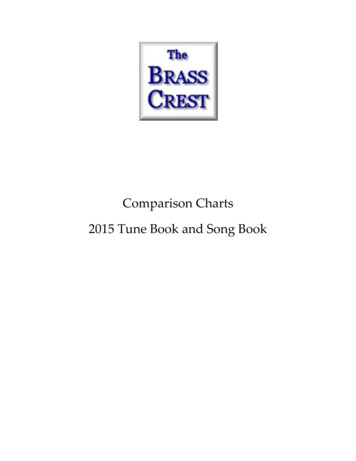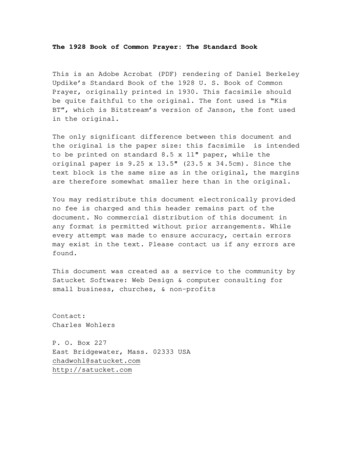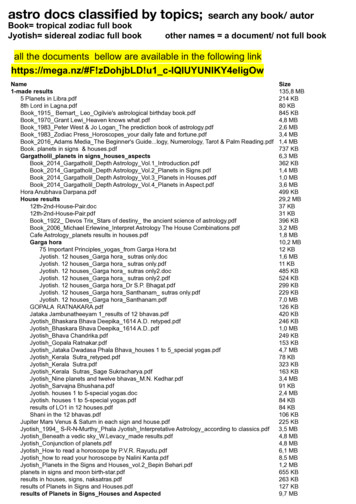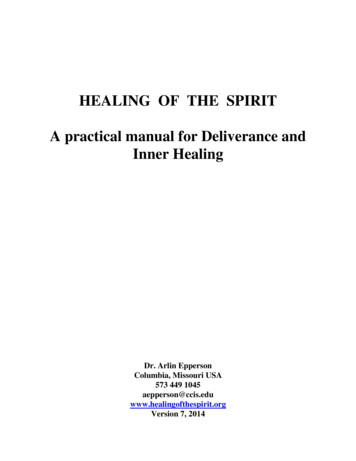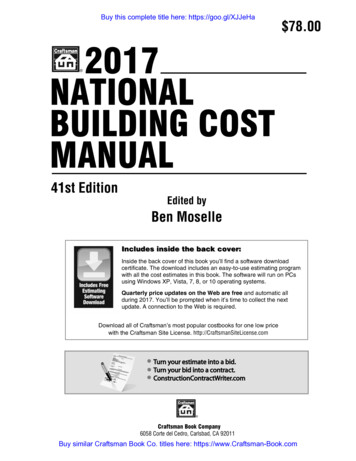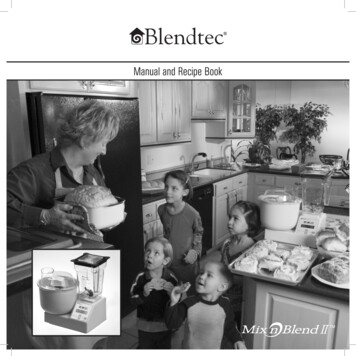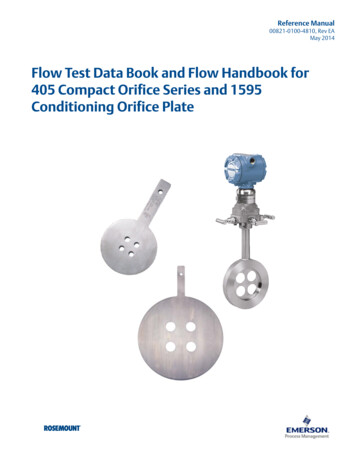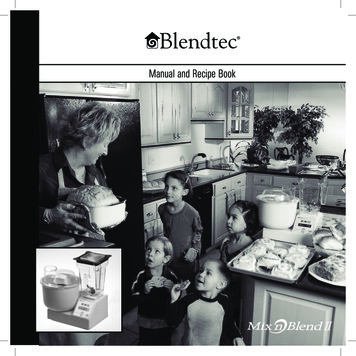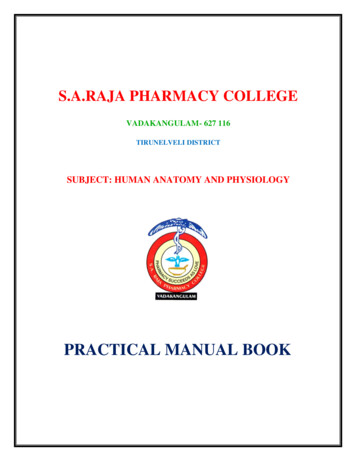
Transcription
S.A.RAJA PHARMACY COLLEGEVADAKANGULAM- 627 116TIRUNELVELI DISTRICTSUBJECT: HUMAN ANATOMY AND PHYSIOLOGYPRACTICAL MANUAL BOOK
LAB MANUALHUMAN ANATOMY AND PHYSIOLOGY( I - B. Pharm and I - D. Pharm)Experiment - ICOMPOUND MICROSCOPEObjects which are ordinarily not visibleby naked eye are seen with microscope.Generally an object smaller than 0.1 mmcannot be seen by our eyes. Therefore, toobserve an object smaller than this, compoundmicroscope is very helpful. Hand lens(magnifying lens) is also a type of microscopebut its magnifying capacity is very low.Dissecting microscope is also used to visualizetiny things, but it has only one lens. Compoundmicroscope is generally used in thelaboratories. Therefore, description, use andmaint enance of ordinary compoundmicroscope is mentioned here.base of this, stage is fixed. On the topof the arm body tube of the microscopeis fixed and two knobs are fitted. One isfor the coarse adjustment and the otherfor the fine adjustment. These are usedfor focussing the body tube.(c) Body Tube : This is attached to the knob ofthe arm. It has one lens on the upperend known as eye piece. This lens canbe changed according to the requiredmagnificaton. On the bottom of thistube there is a nose piece. Two to fourlenses can be fitted in this nose piece.Because the lenses are fitted on theobject ive, these are known asobjective lenses. These are fitted inthe body tube, known as objectivelens body. The objective lens body isfitted into the noise piece.1.1 Parts of a CompoundMicroscopeTake out the microscope from the boxholding the arm by one hand and supportingthe base by another hand. Place carefully onthe table and study the names and functions ofthe parts as mentioned in the figure. The partsof a compound microscope can been dividedinto 4 main parts:(d) Stage : It is a platform having a circular holein the centre to allow the passage forlight from below. It is fixed to the baseby the stand. One mirror is fixed to thestand. It is known as reflecting mirror.Below the stage is a condenser throughwhich concentrated beam of light passes.Iris diaphragm is also attached to thecondenser. The reflecting mirror reflectsthe light upward through the iris anddiaphragm. This beam of light passesthrough the hole in the stage and providelight to the object kept on the slide.There are two clips for holding(a) Base : This is U-shaped lower portion of themicroscope on which the other parts ofthe microscope lie. Above the U-shapedportion, there is a perpendicular portionknown as the pillar. On the top of this,another arm is fixed. This is known asinclination joint. This can be used to tiltthe microscope at a desired angle.(b) Arm : It supports the body tube and base ofthe microscope. This portion is used tohold or carry the microscope. On the1
the slide above the hole on the stage.Operation (Use) : Keep a clean prepared slidein the centre of the stage. Use clips tofix the slide on the stage so that it doesnot move. Now move the body tubeby the help of coarse adjustmentknobs. Bring the slide in focus underthe objective lens. Focussing shouldbe made sharp by the use of fineadjustment knobs. When the focus issharp then study the slide. Thespecimen is viewed by keeping oneeye on the eye piece and the secondeye should be kept open. This type ofcompound microscope is known asmonocular compound microscope.Some compound microscopes have twobody tubes. So there are 2 eye pieces andspecimen can be viewed by both the eyes. Suchtype of compound microscope is known asbinocular compound microscope. In theresearch work generally bioncular compoundmicroscope is used.1.2 How to use a CompoundMicroscopeare also available. The multiplication ofmagnification of eye piece and nose piecedenotes the size of the object underobservation.Maintenance of Microscopes:Microscope is a costly equipment.Therefore, it should be handled carefully.Always keep the microscope in an uprightposition while taking it from one place toanother. As far as possible don’t tilt the arm.Clean the lenses of the microscope with thelens paper or muslin cloth, never with the filteror any other kind of paper. If you are using thehigh power objective lens then after theobservation is over, turn the nose piece andbring low power objective lens in line with thehole in the stage. Objective lens should be keptatleast 1 cm above the stage. After using themicroscope always keep it in the box. Takecare to see that the stage of microscope, theeye piece, the objective lens are dry and clean.No chemical should stick to these. Adjustmentknobs and joints should be protected fromrusting by applying vaseline.To use the microscope first of all rotatethe nose piece until the low power objectivesis in line with the body tube and clicks intoposition. Open the iris diaphragm. Lookthrough the eye piece, adjust the mirror anddiaphragm to set a complete field of vision.Place the slide you want to examine on thestage of the microscope and by the help ofthe clips fix it. Move the slide till the objectcomes roughly to the centre of the hole or thestage. Bring the object into focus using thecoarse adjustment knob. Turn the fineadjustment knob to bring the object intosharp focus.How much magnification the objectneeds will be learnt through experience.Eye lenses of 5x, 10x or 15x are available.Some way objective lenses of 4x, 10x & 40xFig. 1.1 A compound microscope
Experiment – IIHistology1. Ciliated Epithelium tissue :Ciliatedcolumnarepithelial cells arerectangular in shapeand have between 200to300hair-likeprotrusions called cilia.The mitochondria arefoundtowardtheapical region of the cellwhile the cell nuceliare found towards thebase and are oftenelongated. Cells areinterconnectedviadesmosomses and tightjunctions, creating asemipermeablemembrane that is moreselectivethatmembrane found inother types of cell.2. Cuboidal Epithelium :Cuboidal epithelia are epithelial cells having a cube-like shape; that is, their width isapproximately equal to their height. They may exist in single layers (simple cuboidal epithelium) ormultiple layers (stratified cuboidal epithelium) depending on their location (and thus function) in thebody.
3. Stratified Columnar Epithelium :Stratified columnar epithelia are found in the ocular conjunctiva of the eye, in parts of thepharynx and anus, the female's uterus, the male urethra and vas deferens. Also found in Lobarducts in salivary glands. The cells function in secretion and protection. In simple terms, we cansay that the upper and lowermost layer of cells are columnar in shape. The middle layer containscuboidal cells. It forms the lining of respiratory tract, ureter, ovi duct ,etc.4. Stratified Cuboidal Epithelium :Stratified cuboidal epithelium is a type of epithelial tissue composed of multiple layersof cube-shaped cells.Only the most superficial layer is made up of cuboidal cells, and the other layers can be cells ofother types. This is because, conventionally, naming of stratified epithelium is based on the typeof cell in the most superficial layer.
4.Areolar connective tissue :Loose connective tissue is the most common type of connective tissue in vertebrates. It holds organsin place and attaches epithelial tissue to other underlying tissues. It also surrounds the blood vessels andnerves. Cells called fibroblasts are widely dispersed in this tissue; they are irregular branching cells thatsecrete strong fibrous proteins and proteoglycans as an extracellular matrix. The cells of this type of tissueare generally separated by quite some distance by a gelatinous substance primarily made up ofcollagenous and elastic fibers.5. Hyaline cartilage :Hyaline cartilage is covered externally by a fibrous membrane, called the perichondrium,except at the articular ends of bones and also where it is found directly under the skin, i.e. earsand nose. This membrane contains vessels that provide the cartilage with nutrition.Hyaline cartilage matrix is mostly made up of type II collagen and chondroitin sulfate, both ofwhich are also found in elastic cartilage.Hyaline cartilage exists on the ventral ends of ribs; in the larynx, trachea, and bronchi; and on thearticular surface of bones
6. Tendon :A tendon (or sinew) is a tough band of fibrous connective tissue that usually connects muscle tobone and is capable of withstanding tension. Tendons are similar to ligaments and fasciae; allthree are made of collagen. Ligaments join one bone to another bone; fasciae connect muscles toother muscles. Tendons and muscles work together to move bones.7. Human Vein :Veins (from the Latin vena) are blood vessels that carry blood toward the heart. Most veins carrydeoxygenated blood from the tissues back to the heart; exceptions are the pulmonary andumbilical veins, both of which carry oxygenated blood to the heart. In contrast to veins, arteriescarry blood away from the heart. Veins are less muscular than arteries and are often closer to theskin. There are valves in most veins to prevent backflow.
8. Cardiac Muscle :Cardiac muscle (heart muscle) is involuntary, striated muscle that is found in the walls andhistological foundation of the heart, specifically the myocardium. Cardiac muscle is one of threemajor types of muscle, the others being skeletal and smooth muscle. These three types of muscleall form in the process of myogenesis. The cells that constitute cardiac muscle, calledcardiomyocytes or myocardiocytes, contain only three nuclei.[1][2][page needed] The myocardium isthe muscle tissue of the heart, and forms a thick middle layer between the outer epicardium layerand the inner endocardium layer.9.Smooth Muscle :Smooth muscle is an involuntary non-striated muscle. It is divided into twosubgroups; the single-unit (unitary) and multiunit smooth muscle. Within single-unitcells, the whole bundle or sheet contracts as a syncytium (i.e. a multinucleate mass ofcytoplasm that is not separated into cells). Multiunit smooth muscle tissues innervateindividual cells; as such, they allow for fine control and gradual responses, much likemotor unit recruitment in skeletal muscle.Smooth muscle is found within the walls of blood vessels (such smooth musclespecifically being termed vascular smooth muscle) such as in the tunica media layer oflarge (aorta) and small arteries, arterioles and veins. Smooth muscle is also found inlymphatic vessels, the urinary bladder, uterus (termed uterine smooth muscle), male andfemale reproductive tracts, gastrointestinal tract, respiratory tract, arrector pili[1] of skin,the ciliary muscle, and iris of the eye. The structure and function is basically the same insmooth muscle cells in different organs, but the inducing stimuli differ substantially, inorder to perform individual effects in the body at individual times. In addition, theglomeruli of the kidneys contain smooth muscle-like cells called mesangial cells.
10.Neuron :Nervous tissue is the main component of the two parts of the nervous system; the brain andspinal cord of the central nervous system (CNS), and the branching peripheral nerves of the peripheralnervous system (PNS), which regulates and controls bodily functions and activity.11.Adipose tissue :adipose tissue or body fat or just fat is loose connective tissue composed mostly ofadipocytes. In addition to adipocytes, adipose tissue contains the stromal vascular fraction (SVF) of cellsincluding preadipocytes, fibroblasts, vascular endothelial cells and a variety of immune cells (i.e., adiposetissue macrophages [ATMs]). Adipose tissue is derived from preadipocytes. Its main role is to storeenergy in the form of lipids, although it also cushions and insulates the body. Far from hormonally inert,adipose tissue has, in recent years, been recognized as a major endocrine organ, [1] as it produces hormonessuch as leptin, estrogen, resistin, and the cytokine TNFα. Moreover, adipose tissue can affect other organsystems of the body and may lead to disease. The two types of adipose tissue are white adipose tissue(WAT), which stores energy, and brown adipose tissue (BAT), which generates body heat.
Experiment - IIIHEAMATOLOGYESTIMATION OF HEMOGLOBIN BY SAHALI’S METHODAIM: To determine the hemoglobin content in 20µl of blood sample.PRINCIPLE: A hemoprotein composed of globin and heme that gives redblood cells their characteristic color; function primarily to transport oxygen fromthe lungs to the body tissues. The red blood cells are broken down withhydrochloric acid to get the hemoglobin into a solution. The free hemoglobin isexposed for a while to form hemin crystals. The solution is diluted to comparewith a standard colour.MATERIALS: Hemometer, Single mark pipette, Distilled water, Needle,Spirit, Cotton, HCl.PROCEDURE: Take 1/10 HCl in the Hb tube upto the lowest mark ‘2’.2. Prick the finger with needle and collect 20µl of blood sample with singlemark pipette.3. Place the Hb tube on working table for five minutes for the formation ofhemin crystals.4. Place the Hb tube in the compater/hemometer and add drop by drop ofdistilled water into it until the colour of the solution in the Hb tube coincideswith the glass plates of the compater.5. If the colour coincides with the glass plates of the compater, observe thereading in the Hb tube. The percentage of Hb can be calculated from thereading.DATA ANALYSIS: Hb content in grams X 100 / 14.5NORMAL VALUES: Males 14 to 18 gramsFemales 13 to 14 gramsChildren 10 to 13 gramsRESULT: The hemoglobin content present in 20µl of blood sample is
Experiment – IVDetermination of Bleeding TimeAimTo determine the bleeding time of a patient.TheoryThe time required for complete stopping of blood flow from the punctured blood vessels calledthe bleeding time. Normally it is 1-3 minutes for a normal human's blood. Normal clotting timeand bleeding time values differ because bleeding time is the time for stopping bleeding by theformation of fibrin network on the surface of punctured skin; that is it is the surface phenomenon.B
inclination joint. This can be used to tilt the microscope at a desired angle. (b) Arm : It supports the body tube and base of the lightmicroscope. This portion is used to hold or carry the microscope. On the base of this, stage is fixed. On the top of the arm body tube of the microscope

